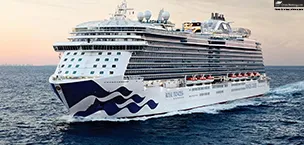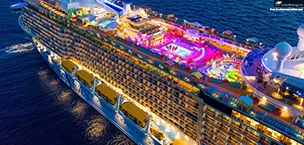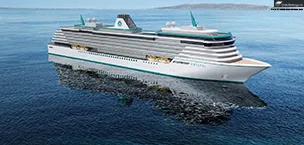The MSC Euribia is making its way to the Middle East for its upcoming winter season in the United Arab Emirates and the Arabian Gulf. The ship, powered by LNG (liquefied natural gas), is currently sailing around Africa after MSC Cruises canceled its original repositioning route through the Red Sea due to ongoing security concerns in the region.
The vessel’s extended voyage began in mid-October from Northern Europe and included a brief technical stop in Las Palmas de Gran Canaria. After completing this call, the ship continued its journey south toward Africa, where it is expected to arrive in Durban, South Africa, later this month. This marks a major milestone in its repositioning journey before it begins the final leg toward the Middle East.
Once the MSC Euribia reaches Dubai, the ship will kick off its second winter season in the region. Starting November 8, 2025, the vessel will welcome guests on board for a series of weeklong cruises exploring popular destinations across the Arabian Gulf.
Each itinerary will include visits to ports such as Abu Dhabi, Sir Bani Yas, and Khalifa Bin Salman in Bahrain, as well as a stop in Qatar. The cruises are designed to showcase the blend of modern cities, cultural sites, and pristine beaches that make this region increasingly popular among winter travelers.
The 2023-built MSC Euribia, which can accommodate nearly 4,900 guests, has quickly become one of MSC Cruises’ flagship vessels. Known for its advanced environmental technology, stylish interiors, and extensive entertainment options, the ship continues to attract travelers seeking a mix of comfort and sustainability at sea.
MSC Cruises plans to operate these Middle East sailings through early April 2026. After completing the winter deployment, the Euribia will begin another long voyage back to Europe. Because of continued restrictions in the Red Sea, the return trip will once again take the ship around Africa instead of the traditional Suez Canal route.
Once in Europe, the ship will start its summer season sailing through the Northern Fjords, offering guests the chance to experience some of Scandinavia’s most scenic landscapes.
With the Red Sea still considered unsafe for commercial cruise operations, many cruise lines have been forced to adjust to their plans. Costa Cruises and AIDA Cruises decided earlier this year to cancel all scheduled Middle East sailings. Both brands redeployed their ships to Northern Europe and the Mediterranean instead.
Meanwhile, Celestyal Cruises has confirmed that it will move ahead with its Middle East plans. Its ships are set to travel through the Red Sea with guests onboard, stopping in Jeddah, Saudi Arabia, before continuing to the United Arab Emirates and Qatar without passengers on the final stretch.
TUI Cruises has also taken a similar approach to MSC by rerouting its repositioning sailing around Africa. Its ships are currently sailing the long way to the Arabian Gulf, carrying guests along the journey and offering a unique experience across multiple continents.
By taking this alternative route, MSC Euribia not only avoids the Red Sea conflict zone but also turns its repositioning into an extended global voyage. The decision highlights the flexibility cruise lines continue to show as they adapt to changing regional conditions while keeping guests safe at the forefront.
Royal Princess Named 2025 World’s Best Culinary Cruise Ship
Princess Cruises has proudly announced that its Royal Princess has been named the 2025 “World’s Best Culinary Cruise Ship” by the World Culinary Awards. This award is a major recognition, […]
Carnival Study Shows Australians Go Batty for Halloween
Halloween is growing bigger than ever in Australia, and Carnival Cruise Line is helping Australians celebrate in style. A recent study by the company found that 58 percent of Australian […]
East Coast Storm Keeps Cruise Ships Anchored in New York
A hurricane-like storm that was off the coast of the eastern United States led to the cruise industry suffering the most as it caused a slew of delays to four […]
Crystal Announces Plans for a New Ship Coming in 2028
Crystal has shared two key dates for its upcoming new ship being built by Fincantieri, which is expected to be delivered in May 2028. This marks the first new ship […]



